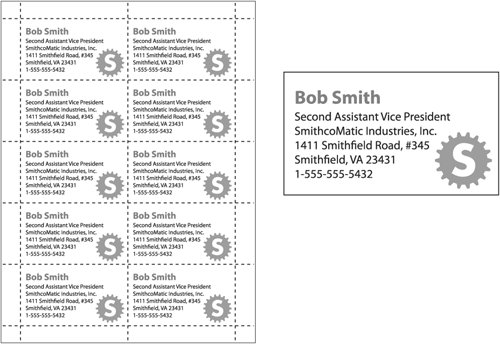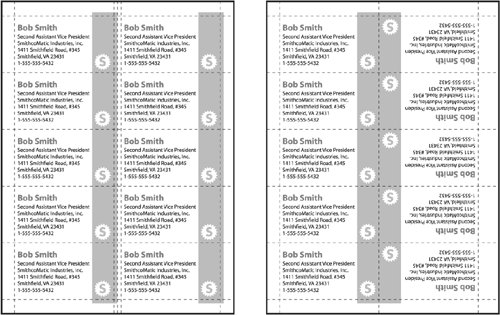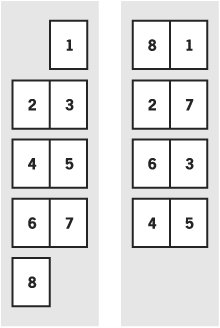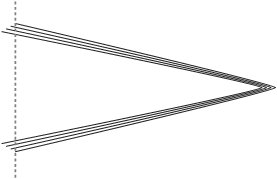Imposition
| The process of laying out individual pages or other pieces in final printing position is called imposition. The size and configuration of an imposition arrangement is dictated by the dimensions and printing orientation of the paper running through the press. For simple pieces such as business cards, the imposition may consist of the same piece printed repeatedly. Basic ImpositionAs mentioned earlier in this chapter, business cards don't shoot out of the press one by one. Multiple cards are laid out on each sheet, then cut apart. If you've created business cards on a desktop printer, you have some idea of what's involved. It's fun trying to get those perforated little rascals to line up with the perforations on your desktop printer's output, isn't it? That alone should give you some sympathy for the challenges faced by a commercial print service provider. Imposing a simple business card with a plain, white background (Figure 3.13) is fairly straightforward. Line them up and cut them apart. Figure 3.13. Simple, ten-up imposition for homemade business cards. Looks easy enough (dashed lines indicate trim). However, if there is artwork that needs to bleed off the edge of the card, the imposition and trimming process must ensure that, if there are small errors in the process, remnants of one card don't appear on the edge of the adjacent card (Figure 3.14). Figure 3.14. Oops. The heartbreak of poor trim (left). A proper, well-trimmed business card (right). To avoid messy edges on cards with artwork that bleeds, the prepress operator has to be a bit creative with the multicard layout, arranging the art so that similar sides of the cards print adjacent to each other (Figure 3.15). Keep this in mind the next time you're printing homemade cardsit may save you some aggravation and some paper. Figure 3.15. Bleeding artwork presents additional challenges during imposition and trimming. Here are two possible solutions to trimming cards with bleed (dashed lines indicate trim).On the left, a double-trim layout (easy to lay out, but requires an additional cut). On the right, a more economical layout to accommodate a single cut.  Multipage ImpositionLet the spatial reasoning games begin! As you move beyond single pieces like business cards, you won't be surprised to discover that things get a bit trickier. When multipage pieces are imposed, the sheet is folded and trimmed to become a group of printed pages, called a signature. Depending on the page size, the press capabilities, and the type of binding to be used, a signature could comprise 8, 16, 32, or more pages. This might be a good time to get a little destructive in the name of science. Buy (or borrow) a weekly news magazine and leaf through it. The pages appear, as you might expect, in reader's spreads: 23, 45, 67, and so on. But pry out the staples at the center of the magazine and note how the pages were printed. For example, in a saddle-stitched 96page magazine, you'll find that page 96 is printed across from page 1, page 2 is across from page 95, 943, and so on. Thus, the term printer's spreads (Figure 3.16). Figure 3.16. Reader's spreads (left) compared to pages imposed in printer's spreads (right). Pages four and five face each other in both examples because they make up the center spread. If the spatial reasoning challenge of figuring out which pages should face each other on the final printed sheet frightens you, there is good news: You don't have to build your files in printer's spreads. In fact, you shouldn't. It's better to let the print service provider take care of imposition. Build your document as two-page reader's spreads. Additionally, don't build your spreads as single pages (that is, don't put pages two and three on one big page). If your print service provider requests that you supply files already in printer's spreads, you have a right to be concerned. Imposition of pages is a very basic printing service, and a printer who lacks that capability is likely to fall short in other areas. Asking you to perform imposition places additional responsibility on you, and the complexity of imposition increases proportionally with the number of pages in your publication. Since facing pages don't actually print next to each other (except for the center spread), a number of errors can creep in. Variations in ink coverage across a press sheet may result in colors not matching, and errors in print, trim, and binding can cause crossover elements to be misaligned in the finished piece (Figure 3.17). Figure 3.17. Reader spreads as they appear onscreen (left), compared to printer spreads exhibiting printing and binding problems (right). Color and binding errors are exaggerated for dramatic effect. Usually the results are not as dramatic as shown in Figure 3.17, but you should take the possibilities into consideration as you design. Is there a crucial piece of artwork that needs to span two pages? If so, it will fare best if it's placed on the center spread, where it will print intact. Now that you know that most spreads are not printed together, this may also inspire you to avoid placing photographs so that they extend onto a facing page. Since the pages aren't printed together, even a very slight variation in ink coverage between the pages could become obvious where the two portions of the photograph meet at the center. It might be better to stop the photograph at the inner edge of one page rather than continuing it onto the facing page. You might consider modifying your design to allow for these issues. Move artwork away from the center fold to avoid crossover issues entirely. That's not cheating, it's planning. Keep in mind that the awful outcome depicted in Figure 3.17 is a worst-case scenario. The printing and binding process is not usually this sloppy (if it is, it's time to find a new print service provider). But it gives you an idea of what can go wrong. To get a feel for how your piece is actually printed, folded, and trimmed, ask your print service provider to give you a folding dummy for your job. It's a folded and numbered blank representation of how your pages will be printed, and it's very helpful as you contemplate the realities of your job. If you're given to origami, you can make your own miniature folding dummy for an eight-page document by following the illustration below. This isn't meant to replace an authentic folding dummy created by your printer. It's just a great way for you to get some sense of what really goes on when your pages are split apart and grafted back together in the finished, imposed piece (Figure 3.18). If you want a true representation of how your job will print and fold, consult with the printer's customer service representative who is handling your job. They can help you communicate with the bindery department. Figure 3.18. A simple folding dummy for an eight-page document. Note how the pages are printed, and the order in which the folds occur. If you're creating a piece that contains a fold-in panel, remember that the fold-in panel will be short-trimmed, and position your art accordingly, allowing for at least .125 of an inch less page width on those pages. Build the file as shown in Figure 3.19, wherein the dashed lines over pages six and seven indicate the short trim. Figure 3.19. Visualizing an eight-page brochure containing a fold-in panel. Note that the page numbers are just for identification. You'll have to decide whether to number pages by position in the document or by viewing order. For example, as this piece is opened, the pages would be viewed in this order: 12347568910. Not surprisingly, many designers elect to omit page numbers in such brochures. Feel free to claim that page numbers would just detract from your fresh, clean design. It's not just the width and height you have to worry about when preparing your piece for print. Paper thickness also contributes to the behavior of a finished printed product. To illustrate, stack several sheets of heavy paper, and then fold the stack in the middle. Notice what happens to the edges of the individual pieces of paperthey don't line up, because the cumulative paper thickness at the fold drives the innermost pages out (Figure 3.20). This is called page creep. The more pages (and the heavier the stock), the more pronounced the effect. Figure 3.20. Paper thickness causes edges of pages to creep outward during binding. When the finished pages are trimmed, artwork on the inner pages will be closer to the trim edge. But look at a publication such as a weekly magazine: All the pages are nice and even because the finished piece is trimmed. Of course, this makes for a more attractive magazine, but consider the side effects. Artwork near the edge of the page would be even closer to the trimmed edge of the page on the innermost pages, so the appearance of some elementssuch as page numberswould become inconsistent. The fix? To maintain a consistent outer margin despite the page creep, the page content must be shifted incrementally to compensate, a process known as shingling. The closer a page is to the center of the magazine, the more content must be moved very slightly inward. While this results in tighter margins at the center, the result is usually less noticeable than margin errors on the outside edges of the pages (Figure 3.21). Figure 3.21. The results of shingling to compensate for page creep during folding. The outermost pages of a signature (left) are fine. But to keep the external margins consistent throughout the bound piece, page content is moved inward, which results in tighter inner margins (right). The good news is that designers aren't expected to do shingling. It's done by the print service provider as part of the imposition process, which positions individual pages correctly for final printing, trimming, and binding. But you should still be mindful of the process as you design your pages so you can minimize problems. It helps if you have generous inside margins so that moving content inward during shingling won't cause any artwork to be crammed into the spine of the printed and bound piece. Some binding processes incur shingling more frequently (or to a more pronounced degree) than others. As you might expect, binding a relatively large number of pages, such as those in a weekly magazine, will result in the need for more shingling than binding a publication containing only eight pages. |
EAN: 2147483647
Pages: 132






